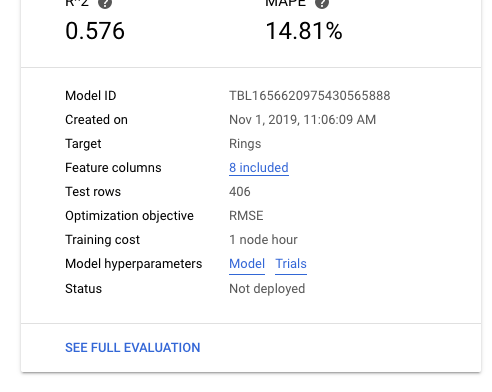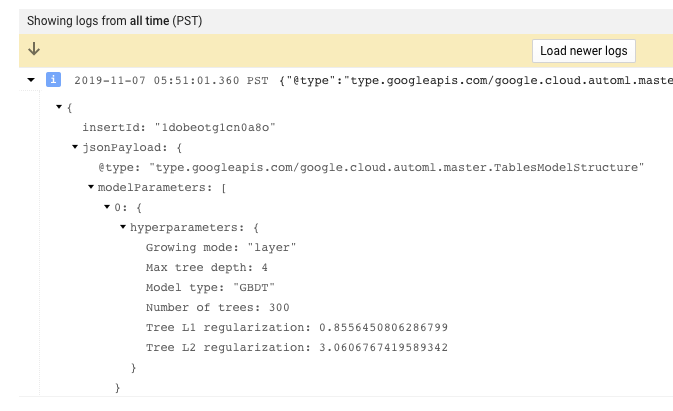This page provides information on how to use Cloud Logging to view details about an AutoML Tables model. Using Logging, you can see the final model hyperparameters as well as the hyperparameters and object values used during model training and tuning.
You can also view general logs for AutoML Tables in your project.
Logged data
The logging messages produced by AutoML Tables provide:
- Final model hyperparameters as key-value pairs.
- Hyperparameters used during tuning trials, as well as an objective value.
By default, logs are deleted after 30 days.
Before you begin
- Familiarize yourself with Cloud Logging.
Permissions required for this task
To perform this task, you must have the following permissions:
logging.logServiceIndexes.liston the projectlogging.logServices.liston the project
Viewing training logs
Accessing model logs from the Google Cloud console
You can access the final hyperparameter logs and the tuning trial hyperparameter logs directly from AutoML Tables.
Go to the AutoML Tables page in the Google Cloud console.
Select the Models tab in the left navigation pane and click on the model name to open the model.
Select the Models tab.

To see the final hyperparameter logs, click Model.
To see the tuning trial hyperparameters, click Trials.
Expand the payload as shown below:

Reading model architecture logs
Activity logs are structured as described in the LogEntry type documentation.
AutoML Tables model logs have, among other fields:
automl_tablesas the value of thelog_typefieldjsonPayloadthat contains the specific details of the log entrytimestampthat describes when the model was created
Payload contents
The contents of a log entry are provided in JSON object format and
are stored in the jsonPayload field. The jsonPayload field
contains the following information.
| Field | Type | Description |
|---|---|---|
modelStructure |
JSON |
A description of the AutoML Tables model structure.
This field contains one or more See the hyperparameter list for details. |
trainingObjectivePoint |
JSON | The optimization objective used for model training. This entry includes a timestamp and an objective value at the time the log entry was recorded. |
List of hyperparameters
The hyperparameter data provided in the logs differ for each type of model. The following sections describe the hyperparameters for each model type.
AdaNet models
- Model type:
AdaNet - AdaNet lambda
- Complexity type
- Initial number of layers
- Last layer type (
logitsorprelogits) - Grow layer size
- Learn mixture weights (
TrueorFalse) - Learn residuals (
TrueorFalse) - Boosting iterations
Optimizer (
adagradoradam)
AdaNet AutoEnsemble models
- Model type:
AdaNet AutoEnsembler - Number of hidden layers
- Hidden layer size
- Dropout
- L1 regularization strength
- L2 regularization strength
- L2 shrinkage regularization strength
- Tree complexity
- Max tree depth
- Center bias (
TrueorFalse) - Growing mode (
layerortree) - Boosting iterations
DNN Optimizer (
adagradoradam)
DNN Linear models
- Model type:
DNNLinear - Number of hidden layers
- Hidden layer size
- Dropout
- L1 regularization strength
- L2 regularization strength
L2 shrinkage regularization strength
Gradient boosted decision tree models
- Model type:
GBDT - Max tree depth
- Tree L1 regularization
- Tree L2 regularization
- Tree complexity
- Number of trees
Center bias (
TrueorFalse)
Feedforward neural network models
- Model type:
nn - Hidden layer size
- Dropout rate
- Enable numerical embedding (
TrueorFalse) - Enable L1 (
TrueorFalse) - Enable L2 (
TrueorFalse) - Enable embedding L1 (
TrueorFalse) - Enable embedding L2 (
TrueorFalse) - Enable layerNorm (
TrueorFalse) - Enable batchNorm (
TrueorFalse) - Number of hidden layers
- Number of cross layers
- Skip connections type (
dense,disable,concat, orslice_or_padding) - Normalize numerical column (
TrueorFalse)
Sample log entries
The following example shows a log entry for the final model architecture for a
nn model, as indicated by the model_type parameter. If more than one model
was used to create the final model, the hyperparameters for each model are
returned as an entry in the modelParameters array, indexed by position (0, 1,
2, and so on).
{
insertId: "qx7z0ifhtjpkv"
jsonPayload: {
@type: "type.googleapis.com/google.cloud.automl.master.TuningTrial"
modelStructure: {
modelParameters: [
0: {
Dropout rate: 0.75
Embedding numerical embedding: "True"
Enable L1: "False"
Enable L2: "False"
Enable batchNorm: "True"
Enable embedding L1: "False"
Enable embedding L2: "False"
Enable layerNorm: "False"
Hidden layer size: 16
Normalize numerical column: "True"
Number of cross layers: "1"
Number of hidden layers: "2"
Skip connections type: "dense"
Model type: "nn"
}
]
}
trainingObjectivePoint: {
createTime: "2019-10-15T04:52:00Z"
value: 0.002069325
}
}
labels: {
log_type: "automl_tables"
}
logName: "projects/project-id/logs/automl.googleapis.com%2Ftuning"
receiveTimestamp: "2019-10-15T10:46:06.916277805Z"
resource: {
labels: {
job_id: "109476078648557568"
project_id: "project-id"
region: "us-central1"
}
type: "cloudml_job"
}
severity: "INFO"
timestamp: "2019-10-15T10:46:06.916277805Z"
}
The following example shows a log entry for model architecture during tuning.
{
insertId: "nl7815f7p0cjb"
jsonPayload: {
@type: "type.googleapis.com/google.cloud.automl.master.TuningTrial"
modelStructure: {
modelParameters: [
0: {
hyperparameters: {
Boosting iterations: "2"
Grow layer size: "30"
Initial number of layers: "1"
Last layer type: "prelogits"
Learn residuals: "False"
Model type: "AdaNet"
Optimizer: "adam"
}
}
]
}
trainingObjectivePoint: {
createTime: "2019-10-13T20:42:25Z"
value: 0.0000011595778
}
}
labels: {
log_type: "automl_tables"
}
logName: "projects/project-id/logs/automl.googleapis.com%2Ftuning"
receiveTimestamp: "2019-10-13T21:20:08.189302731Z"
resource: {
labels: {
job_id: "2804289077287845888"
project_id: "project-id"
region: "us-central1"
}
type: "cloudml_job"
}
severity: "INFO"
timestamp: "2019-10-13T21:20:08.189302731Z"
}
Viewing general AutoML Tables logs
You can see your project's activity logs through the Logs Explorer in the Google Cloud console:
- Go to the Logging page in the Google Cloud console.
- When in the Logs Explorer, select and filter your resource type from the first drop-down menu.
- Select automl.googleapis.com/tuning from the All logs drop-down menu to see the AutoML Tables logs.
Exporting logs
You can export your logs to BigQuery, Cloud Storage, or Pub/Sub.
Read Configuring Logs Export in the Logging documentation to learn how to export activity logs.
